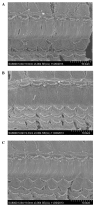Protection of the cochlear hair cells in adult C57BL/6J mice by T-type calcium channel blockers
- PMID: 26998034
- PMCID: PMC4774483
- DOI: 10.3892/etm.2016.2970
Protection of the cochlear hair cells in adult C57BL/6J mice by T-type calcium channel blockers
Abstract
The aim of the present study was to investigate the protective effect of T-type calcium channel blockers against presbycusis, using a C57BL/6J mice model. The expression of three T-type calcium channel receptor subunits in the cochlea of 6-8-week-old C57BL/6J mice was evaluated using reverse transcription-quantitative polymerase chain reaction. The results confirmed that the three subunits were expressed in the cochlea. In addition, the capacity of T-type calcium channel blockers to protect the cochlear hair cells of 24-26-week-old C57BL/6J mice was investigated in mice treated with mibefradil, benidipine or saline for 4 weeks. Differences in hearing threshold were detected using auditory brainstem recording (ABR), while differences in amplitudes were measured using a distortion product otoacoustic emission (DPOAE) test. The ABR test results showed that the hearing threshold significantly decreased at 24 kHz in the mibefradil-treated and benidipine-treated groups compared with the saline-treated group. The DPOAE amplitudes in the mibefradil-treated group were increased compared with those in the saline-treated group at the F2 frequencies of 11.3 and 13.4 kHz. Furthermore, the DPOAE amplitudes in the benidipine-treated group were increased compared with those in the saline-treated group at an F2 frequency of 13.4 kHz. The loss of outer hair cells (OHCs) was not evident in the mibefradil-treated group; however, the stereocilia of the inner hair cells (IHCs) were disorganised and sparse. In summary, these results indicate that the administration of a T-type calcium channel blocker for four consecutive weeks may improve the hearing at 24 kHz of 24-26-week-old C57BL/6J mice. The function and morphology of the OHCs of the C57BL/6J mice were significantly altered by the administration of a T-type calcium channel blocker; however, the IHCs were unaffected.
Keywords: T-type calcium channel; calcium channel blocker; hair cell; receptor.
Figures



Similar articles
-
Protective Efficacy of T-type, Calcium Channel Antagonist on Auditory Function in Cdh23 Erl/Erl Mice.Altern Ther Health Med. 2025 Jan;31(1):82-88. Altern Ther Health Med. 2025. PMID: 39480672
-
[Protection of T-type calcium channel blocker in spiral ganglion neurons of adult C57BL/6J mice].Zhonghua Yi Xue Za Zhi. 2014 Sep 23;94(35):2781-5. Zhonghua Yi Xue Za Zhi. 2014. PMID: 25533990 Chinese.
-
Effect of T-type calcium channel blockers on spiral ganglion neurons of aged C57BL/6J mice.Int J Clin Exp Med. 2015 Sep 15;8(9):15466-73. eCollection 2015. Int J Clin Exp Med. 2015. PMID: 26629036 Free PMC article.
-
Differential effects of salicylate, quinine, and furosemide on Guinea pig inner and outer hair cell function revealed by the input-output relation of the auditory brainstem response.J Am Acad Audiol. 2011 Feb;22(2):104-12. doi: 10.3766/jaaa.22.2.5. J Am Acad Audiol. 2011. PMID: 21463565
-
Genetic influences on susceptibility of the auditory system to aging and environmental factors.Scand Audiol Suppl. 1992;36:1-39. Scand Audiol Suppl. 1992. PMID: 1488615 Review.
Cited by
-
Age-related hearing loss and its potential drug candidates: a systematic review.Chin Med. 2023 Sep 20;18(1):121. doi: 10.1186/s13020-023-00825-6. Chin Med. 2023. PMID: 37730634 Free PMC article. Review.
-
Age-related hearing loss: An updated and comprehensive review of the interventions.Iran J Basic Med Sci. 2024;27(3):256-269. doi: 10.22038/IJBMS.2023.72863.15849. Iran J Basic Med Sci. 2024. PMID: 38333758 Free PMC article. Review.
-
Altered Outer Hair Cell Mitochondrial and Subsurface Cisternae Connectomics Are Candidate Mechanisms for Hearing Loss in Mice.J Neurosci. 2020 Oct 28;40(44):8556-8572. doi: 10.1523/JNEUROSCI.2901-19.2020. Epub 2020 Oct 5. J Neurosci. 2020. PMID: 33020216 Free PMC article.
References
-
- Schuknecht HF, Gacek MR. Cochlear pathology in presbycusis. Ann Otol Rhinol Laryngol. 1993;102:1–16. - PubMed
LinkOut - more resources
Full Text Sources
Other Literature Sources
Miscellaneous
